 W
WAdapidae is a family of extinct primates that primarily radiated during the Eocene epoch between about 55 and 34 million years ago.
 W
WAdapiformes is a group of early primates. Adapiforms radiated throughout much of the northern continental mass, reaching as far south as northern Africa and tropical Asia. They existed from the Eocene to the Miocene epoch. Some adapiforms resembled living lemurs.
 W
WAmbulocetidae is a family of early cetaceans from Pakistan. The genus Ambulocetus, after which the family is named, is by far the most complete and well-known ambulocetid genus due to the excavation of an 80% complete specimen of Ambulocetus natans. The other two genera in the family, Gandakasia and Himalayacetus, are known only from teeth and mandibular fragments. Retaining large hindlimbs, it was once thought that they could walk on land—indeed, their name means "walking whales"—, but recent research suggests they may have been fully aquatic like modern cetaceans.
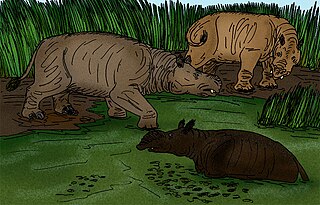 W
WAmynodontidae is a family of extinct perissodactyls related to true rhinoceroses. They are commonly portrayed as semiaquatic hippo-like rhinos but this description only fits members of the Metamynodontini; other groups of amynodonts like the cadurcodontines had more typical ungulate proportions and convergently evolved a tapir-like proboscis. Their fossils have been found in North America, and Eurasia ranging in age from the Middle Eocene to the Early Oligocene, with a single genus (Cadurcotherium) surviving into the Late Oligocene in South Asia (Pakistan). The genus Metamynodon may have survived into the early Miocene.
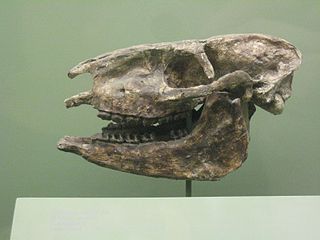 W
WThe Anchitheriinae are an extinct subfamily of the Perissodactyla family Equidae, the same family which includes modern horses, zebras and donkeys. This subfamily is more primitive than the living members of the family. The group first appeared with Mesohippus in North America during the middle Eocene and thrived until the late Miocene. The subfamily continued in Eurasia with the genus Sinohippus until the early Pliocene, when it finally became extinct. This subfamily were considered browsers with their more ancestral low-crowned molars, in contrast with the modern, specialized grazer species today.
 W
WAncylopoda is a group of browsing, herbivorous, mammals in the Perissodactyla that show long, curved and cleft claws. Morphological evidence indicates the Ancylopoda diverged from the tapirs, rhinoceroses and horses (Euperissodactyla) after the Brontotheria, however earlier authorities such as Osborn sometimes considered the Ancylopoda to be outside Perissodactyla or, as was popular more recently, to be related to Brontotheria.
 W
WAnoplotheriidae is an extinct family of even-toed ungulates. They were endemic to Western Europe during the Eocene and Oligocene epochs about 48—23 million years ago (Mya), existing for about 25 million years. They disappeared at the end of the Oligocene, leaving no survivors today. Its name is derived from the Ancient Greek: ἂνοπλος ("unarmed") and θήριον ("beast"), translating as "unarmed beast".
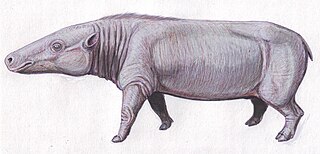 W
WAnthracotheriidae is a paraphyletic family of extinct, hippopotamus-like artiodactyl ungulates related to hippopotamuses and whales. The oldest genus, Elomeryx, first appeared during the middle Eocene in Asia. They thrived in Africa and Eurasia, with a few species ultimately entering North America during the Oligocene. They died out in Europe and Africa during the Miocene, possibly due to a combination of climatic changes and competition with other artiodactyls, including pigs and true hippopotamuses. The youngest genus, Merycopotamus, died out in Asia during the late Pliocene. The family is named after the first genus discovered, Anthracotherium, which means "coal beast", as the first fossils of it were found in Paleogene-aged coal beds in France. Fossil remains of the anthracothere genus were discovered by the Harvard University and Geological Survey of Pakistan joint research project (Y-GSP) in the well-dated middle and late Miocene deposits of the Pothohar Plateau in northern Pakistan.
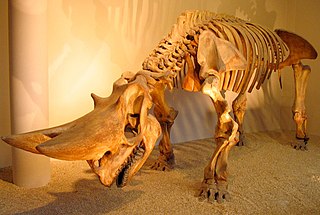 W
WArsinoitheriidae is a family of hoofed mammals belonging to the extinct order Embrithopoda. Remains have been found in the Middle East, Africa, Asia and Romania. When alive, they would have borne a strong but superficial resemblance to modern rhinoceroses; however, they were not closely related to them, instead being more closely related to hyraxes, elephants, sirenians, and possibly desmostylians.
 W
WAsterostomatidae is an extinct family of sea urchins belonging to the order Spatangoida.
 W
WAstrapotheriidae is an extinct family of herbivorous South American land mammals that lived from the Late Eocene to the Middle Miocene 37.8 to 15.97 million years ago. The most derived of the astrapotherians, they were also the largest and most specialized mammals in the Tertiary of South America. There are two sister taxa: Eoastrapostylopidae and Trigonostylopidae.
 W
WBasilosaurinae is a subfamily of cetaceans archaeocetes containing two genera: Basilosaurus and Basiloterus. They were characterized by elongated distal thoracic vertebrae, lumbar, and proximal sacrococcygeal. All known members of the subfamily are larger than their relatives of the Dorudontinae subfamily except Cynthiacetus.
 W
WAmphicyonidae is an extinct family of terrestrial carnivorans belonging to the suborder Caniformia. They first appeared in North America in the middle Eocene, spread to Europe by the late Eocene, and appear in Asia, and Africa by the early Miocene. They had largely disappeared worldwide by the late Miocene, with the latest recorded species at the end of the Miocene in Pakistan. They were among the first carnivorans to evolve large body size. Later in their history, they came into competition with hesperocyonine and borophagine canids. As dogs evolved similar body sizes and cranial and dental adaptations, the rise of these groups may have led to their extinction. Amphicyonids are often colloquially referred to as "bear-dogs".
 W
WBorhyaenidae is an extinct metatherian family of low-slung, heavily built predatory mammals in the order Sparassodonta. Borhaenids are not true marsupials, but members of a sister taxon, Sparassodonta. Like most metatherians, borhyaenids and other sparassodonts are thought to have had a pouch to carry their offspring around. Borhyaenids had strong and powerful jaws, like those of the unrelated placentalians Hyaenodon and Andrewsarchus, for crushing bones. Borhyaenids grew up to an average of 5 to 6 feet long. Borhyaena is the type genus of this group.
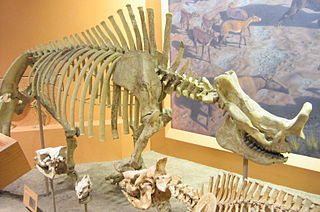 W
WBrontotheriidae, also called Titanotheriidae, is a family of extinct mammals belonging to the order Perissodactyla, the order that includes horses, rhinoceroses, and tapirs. Superficially, they looked rather like rhinos, although they were actually more closely related to horses; Equidae and Brontotheriidae make up the suborder Hippomorpha. They lived around 56–34 million years ago, until the very close of the Eocene.
 W
WCercamoniinae is a subfamily within the extinct primate family Notharctidae primarily found in Europe, although a few genera have been found in North America and Africa.
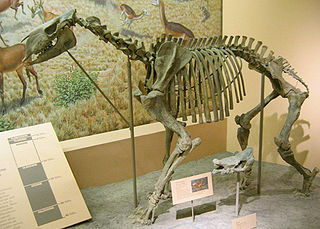 W
WChalicotheres are an extinct clade of herbivorous, odd-toed ungulate (perissodactyl) mammals that lived in North America, Eurasia, and Africa from the Middle Eocene until the Early Pleistocene, existing from 46.2 mya to 781,000 years ago. They are one of the five major radiations of perissodactyls, with three groups living, and two extinct.
 W
WChalicotherioidea is an extinct superfamily of clawed perissodactyls that lived from the early Eocene to the early Pleistocene subepochs. Based on the fossil record they emerged and thrived largely in Eurasia, although specimens have been found in both Africa and North America. They were likely browsers that fed mainly on leaves, twigs, and other nonresistant vegetation. Many of the contained genera had derived specializations of the forelimb and manus that allowed the claws to be used as hooks for browsing and to be kept off of the ground while walking. Chalicotheres lived primarily in forested areas. Size sexual dimorphism and morphological structures such as the domed skulls of Tylocephalonyx suggest agonistic behaviour in some sort of social setting. They are related to modern day horses, rhinoceroses, and tapirs, as well as the extinct brontotheres.
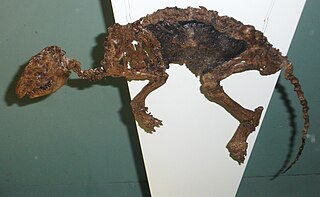 W
WDichobunidae is an extinct family of basal artiodactyl mammals from the early Eocene to late Oligocene of North America, Europe, and Asia. The Dichobunidae include some of the earliest known artiodactyls, such as Diacodexis.
 W
WDiplocynodontinae is a clade of alligatoroid crocodilians that lived from the Eocene to the Miocene in Europe. It includes 10 species and two genera, Diplocynodon and Baryphracta, although Baryphracta may be a junior synonym of Diplocynodon. The fossil range of the group may extend back into the Paleocene depending on whether remains of an alligatoroid from Berru, France belong to a diplocynodontine.
 W
WEntelodonts—sometimes nicknamed hell pigs or terminator pigs—are an extinct family of pig-like omnivores of the forests and plains of North America and Eurasia from the late Eocene to middle Miocene epochs, existing for about 21.23 million years.
 W
WEomyidae is a family of extinct rodents from North America and Eurasia related to modern day pocket gophers and kangaroo rats. They are known from the Middle Eocene to the Late Miocene in North America and from the Late Eocene to the Pleistocene in Eurasia. Eomyids were generally small, but occasionally large, and tended to be squirrel-like in form and habits. The family includes the earliest known gliding rodent, Eomys quercyi.
 W
WEpoicotheriidae is an extinct family of pangolin-like insectivorous mammals which were endemic to North America from the early Eocene to the early Oligocene 55.8—30.9 Ma existing for approximately 24.9 million years . Epoicotheriids were highly specialized animals that were convergent with the golden moles of Africa in the structure of their skulls and forelimbs, and would have had a similar lifestyle as subterranean burrowers.
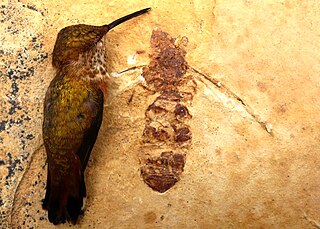 W
WFormiciinae is an extinct subfamily of ants known from Eocene deposits in Europe and North America.
 W
WGround sloths are a diverse group of extinct sloths, in the mammalian superorder Xenarthra. The term is used as a reference for all extinct sloths because of the large size of the earliest forms discovered, as opposed to existing tree sloths. The Caribbean ground sloths, the most recent survivors, lived in the Antilles, possibly until 1550 BC. However, radiocarbon dating suggests an age of between 2819 and 2660 BC for the last occurrence of Megalocnus in Cuba. Ground sloths had been extinct on the mainland of North and South America for 10,000 years or more. They survived 5,000-6,000 years longer in the Caribbean than on the American mainland, which correlates with the later colonization of this area by humans.
 W
WHegetotheriidae is an extinct family of notoungulate mammals known from the Eocene through the Pleistocene of South America.
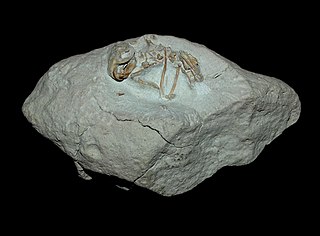 W
WHeliscomyidae is a family of extinct rodents from the mid-Tertiary of North America related to pocket gophers and kangaroo rats and their relatives. The family contains four genera, Apletotomeus, Heliscomys, Passaliscomys, and Tylionomys. McKenna and Bell (1997) placed the first two genera in synonymy, with Heliscomys the senior synonym.
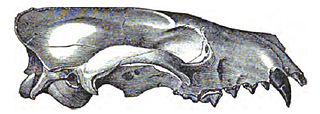 W
WThe extinct Hesperocyoninae are one of three subfamilies found within the canid family. The other two canid subfamilies are the extinct Borophaginae and extant Caninae.
 W
WHomalodotheriidae is an extinct family comprising four genera of notoungulate mammals known from the Late Eocene (Tinguirirican) through Late Miocene (Chasicoan) of Argentina and Chile in South America.
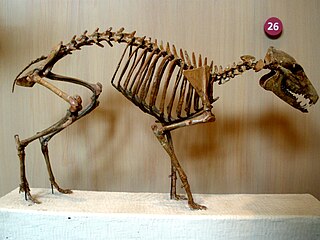 W
WHypertragulidae is an extinct family of artiodactyl ungulates that lived in North America, Europe, and Asia from the Eocene until the Miocene, living 46.2—13.6 million years ago, existing for about 33 million years.
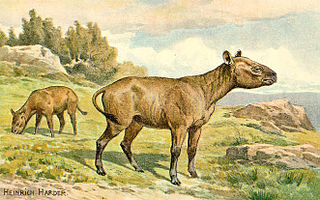 W
WThe Hyracodontidae are an extinct family of rhinoceroses endemic to North America, Europe, and Asia during the Eocene through early Miocene, living from 48.6–26.3 million years ago (Mya), existing about 22.3 million years .
 W
WThe subfamily Indricotheriinae are a group of long-limbed, hornless rhinoceroses commonly known as the paraceratheres that evolved in the Eocene epoch and lived until the early Miocene. The first paraceratheres were only about the size of large dogs, growing progressively larger in the late Eocene and Oligocene. They were most common in the rainforest floodplain region which is now Kazakhstan, India, and southwest China, and lived further inland throughout northern and central Asia as well.
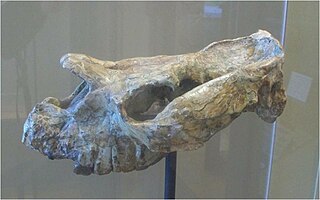 W
WLeontiniidae is an extinct family comprising eleven genera of notoungulate mammals known from the Middle Eocene (Mustersan) to Late Miocene (Huayquerian) of South America.
 W
WLeptomerycinae is an extinct subfamily within the ruminant family Leptomerycidae. It contains three genera, Leptomeryx, Pronodens, and Pseudoparablastomeryx, which lived in North America during the Middle Eocene to Middle Miocene. Leptomeryx may also have occurred in Asia during the Early Oligocene. Leptomerycies were primitive and ancient ruminants, resembling small deer or musk deer, although they were more closely related to modern chevrotains.
 W
WMerycoidodontoidea, sometimes called "oreodonts" or "ruminating hogs", is an extinct superfamily of prehistoric cud-chewing artiodactyls with short faces and fang-like canine teeth. As their name implies, some of the better known forms were generally hog-like, and the group has traditionally been placed within the Suina, though some recent work suggests they may have been more closely related to camels. "Oreodont" means "mountain teeth", referring to the appearance of the molars. Most oreodonts were sheep-sized, though some genera grew to the size of cattle. They were heavy-bodied, with short four-toed hooves and comparatively long tails.
 W
WMesotheriidae is an extinct family of notoungulate mammals known from the Eocene through the Pleistocene of South America. Mesotheriids were small to medium-sized herbivorous mammals adapted for digging.
 W
WNotharctidae is an extinct family of adapiform primates found primarily in North America and Europe.
 W
WNotharctinae is an extinct subfamily of primates that were common in North America during the early and middle Eocene. The six genera that make up the group contain species that are among the most primitive of the adapiform group, which is one of the most primitive groups of primates. The evolutionary history of this subfamily has been comparatively well documented and has been used to argue for evolutionary gradualism. Though it is generally accepted that adapiforms gave rise to modern day lemurs and lorises, it is not currently known which branch of Adapiformes these living species are most closely related to. Notharctines became extinct in the middle Eocene, most likely because of a combination of factors including climatic change and competition with other North American primates.
 W
WNotohippidae is an extinct family of notoungulate mammals from South America. Notohippids are known from the Eocene and Oligocene epochs.
 W
WNotostylopidae is an extinct family comprising five genera of notoungulate mammals known from the Late Paleocene (Riochican) to Early Oligocene (Tinguirirican) of Argentina, Brazil and Chile in South America
 W
WOromerycidae is a small, extinct family of artiodactyls closely related to living camels, known from the middle to late Eocene of western North America.
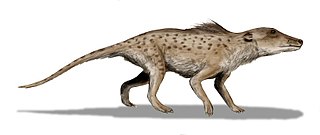 W
WPakicetidae is an extinct family of Archaeoceti that lived during the Early Eocene in Pakistan.
 W
WPalaeochiropterygidae is a family of extinct bats. It was originally erected by the Swiss naturalist Pierre Revilliod in 1917 after discoveries of Palaeochiropteryx fossils from the Messel Pit of Germany. Palaeochiropterygidae was merged into Archaeonycteridae by Kurten and Anderson in 1980, but modern authorities specializing in bat fossils maintain the distinction between the two. It was classified to the unranked clade Microchiropteramorpha by Smith et al. in 2007.
 W
WThe Palaeomerycidae are an extinct family of ruminants in the order Artiodactyla, probably ancestral to deer and musk deer. Palaeomerycids lived in North America, Europe, Africa, Asia, and South America from 33 to 4.9 million years ago, existing for about 28 million years.
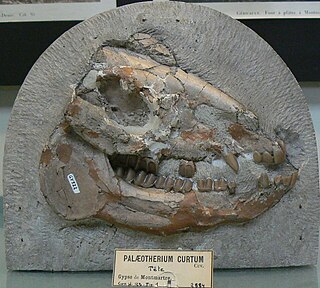 W
WPalaeotheriidae is an extinct family of herbivorous perissodactyl mammals related to equids. They ranged across Europe and Asia from the Eocene through to the early Oligocene 55–33 Ma, existing for approximately 22 million years .
 W
WThe Phiomyidae are a family of prehistoric rodents from Africa and Eurasia. A 2011 study placed Gaudeamus in a new family, Gaudeamuridae.
 W
WProborhyaenidae is an extinct family of metatherian mammals of the order Sparassodonta, which lived in South America from the Eocene (Mustersan) until the Oligocene (Deseadan). Sometimes it has been included as a subfamily of their relatives, the borhyaenids. Body mass estimates suggest that proborhyaenids could weigh up to 150 kilograms (330 lb), making them some of the largest known metatherians. Proborhyaenid remains have been found in western Bolivia, Uruguay, southern Brazil, and the provinces of Mendoza, Salta, and Chubut, in Argentina.
 W
WProrastomidae is a family of extinct sirenians from Jamaica, related to the extant manatees and dugong. The family includes the oldest known fossils of Sirenians, represented in two genera:Pezosiren
 W
WPyrotheriidae is the only family in the order Pyrotheria, provided one does not include the Paleocene genus, Carodnia. These extinct, mastodon-like ungulates include the genera Baguatherium, Carolozittelia, Gryphodon, Propyrotherium, and Pyrotherium. Fossils of the family have been found in Argentina, Brazil, Bolivia and Peru.
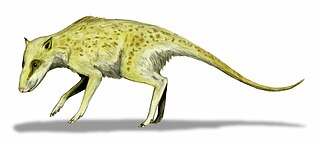 W
WThe Raoellidae, previously grouped within Helohyidae, are an extinct family of semiaquatic digitigrade artiodactyls in the clade Whippomorpha. Fossils of raoellids are found in Eocene strata of South and Southeast Asia.
 W
WRemingtonocetidae is a diverse family of early aquatic mammals of the order Cetacea. The family is named after paleocetologist Remington Kellogg.
 W
WStenoplesictidae is the name of a polyphyletic family of extinct civet-like feliforms.
 W
WZygodactylidae is a family of extinct birds found in Europe and North America from the Eocene epoch to the Middle Miocene. First named in 1971, based on fragmentary remains of two species from Germany, a more complete description of the birds became possible in 2008 when a number of other, better-preserved fossil species were assigned to the family based on a number of shared characteristics.